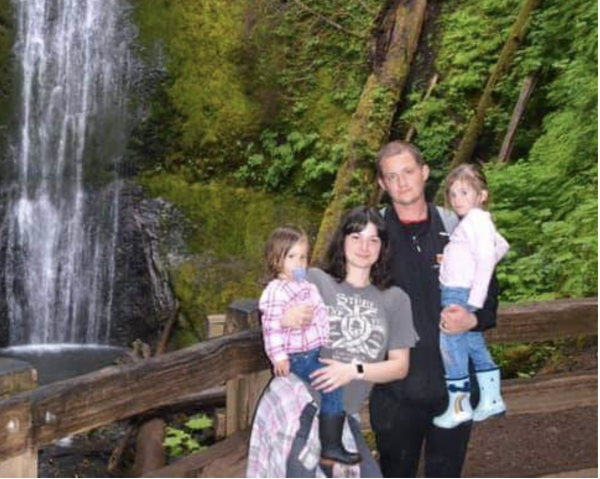Mathew Nichols, from Forks, Washington, had the most bizarre experience on Nov. 19, 2021. The 28-year-old photographer, who works in forest restoration by day, had a clear plan when he set out to Kalaloch Beach on the Washington coast – to capture a lunar eclipse on film.

Nichols knew that it was the last lunar eclipse of the year, so he was determined to immortalize that precious moment with his lens. The cloud cover was too thick, however, and Nichols was unable to photograph the moment. As the saying goes, “when one door closes, another opens.” Something extraordinary happened then that would change his life.
Nichols encountered a strange sight that appeared to be like something straight out of Ghostbusters: Glowing green blobs on a log. Curious, he turned his camera towards the ocean and snapped away at a neon-green bioluminescent fungus, known as “foxfire,” glowing on nearby driftwood.
“I knew I should point my camera toward the ocean during the peak of the eclipse,” Nichols, a father of two, told The Epoch Times. “The moon’s light would be blocked out completely, and to see bioluminescence, there has to be almost no light pollution.

“Once I started taking the shots, I noticed there was no blue glow on the surf, but to my surprise, a green glow on the beach. I immediately walked straight towards the glow to inspect. Initially, I thought maybe someone left their lantern on the beach.”
Success
You are now signed up for our newsletter
Success
Check your email to complete sign up
Upon taking a closer look, Nichols realized it was definitely no lantern. A large log of driftwood was glowing bright green. Then it hit him that he had just found a bioluminescent fungus.
Nichols was so captivated by what he saw that he wanted to learn more about this “glowing” phenomenon.

“Unfortunately, the moon was around full, and it would be a couple of weeks until I could get time at night with no moon in the sky to look for more. Once the time came, I started scouring nearby beaches, finding more and more glowing logs,” Nichols said.
Nichols explained that ocean algae, or phytoplankton, require agitation to glow. Its bioluminescence is a defense mechanism that the microorganisms utilize to ward off predators. Bioluminescent fungus grows on wood washed up from the ocean.
After witnessing this incredible sight, Nichols was eager for more. He visited one of his favorite spots at Third Beach, La Push, a coastal waterfall on Dec. 6, 2021, hoping to capture another similar spectacle.
However, in order for him to achieve his goal, Nichols had to go on a challenging 45-minute hike through lush forest in the dark, at low tide. After what seemed like ages, he finally got as close to the waterfall as he could by the light of the moon.

Once he found the ideal angle, he quickly captured the image of a starfish and glowing log facing the waterfall. Shortly after that snap, Nichols encountered an unexpected surprise that instantly made all that hiking even more worth it.
“I noticed a bobcat about 300 feet in front of me,” he recalled. “When I shone my light at it, it darted toward the ocean … it was hunting in the surf, trying to catch some fish for dinner. [As] it attacked the water, it was disrupting the bioluminescent algae, causing the water to glow bright blue.”
After learning the algae could survive the 36-degree Fahrenheit December temperatures, Nichols, who was already excited and shocked, adjusted his camera and began to snap away for the incredible shots of the waves. “I was ecstatic!” he recalled. “The adrenaline kept me warm that night.”
Nichols’s story of how he became a professional photographer hinges on bioluminescence. In 2018, he moved from Kansas to Forks, Washington with his wife Maleah, and daughters, Aurora, five, and Luna, four. One needs a “real camera” to be a professional photographer, but Nichols was still working with his phone.

Nichols, however, did not let that discourage him. He was inspired by Comet NEOWISE—during the summer of 2020—to become a photographer, and took his phone to the beach during the meteor shower to practice snapping photos so that he would be ready to capture the next once-in-a-lifetime cosmic event.
That night, he discovered something that would change his life forever. Turning his phone towards the ocean, Nichols encountered bioluminescent algae, and in a truly epic fashion, an extraordinary photographer was born.
He purchased his professional camera in April 2021, merely seven months before the encounter on the Washington coast.
Today, Nichols is considered a local expert in the field. To inspire fellow photographers, he manages a Facebook group for all the enthusiasts, Bioluminescence Experience: PNW. This has proved to be a great source of support for his photos.

Many fans love his images so much that they have prints made to hang them on their walls. In his attempt to identify the best days of the year to search for bioluminescence, Nichols came up with a color-coded calendar.
Speaking to The Epoch Times, Nichols shared tips for other photographers hoping to catch this phenomenon on film.
“The most important thing to consider is that there must be little to no light pollution,” he said. “This means you must plan around the moon phases … also, you must let your eyes adjust to the darkness. Flashlights, cellphones, or any artificial lights will seriously dampen your experience.
“Low tide is a great time to experience it, because once you walk close to the ocean, your footprints glow blue from the algae and you can cause a whole tide pool to light up, vibrant blue, by agitating the water.”
Besides that, Nichols emphasized a tripod for long exposure and a huge amount of patience. When it comes to the technical stuff, he prefers a Sony A7iii camera with a 20mm f1.8 Sony lens for most shots, stacks images to reduce “noise,” and edits in Adobe Lightroom to tone down the glow to make it more true to life.

Bioluminescence exists on the U.S. coastline countrywide, but Nichols warned that pursuing it can prove to be a dangerous activity if one is reckless. Thus, he insists that anyone heading out to see the glow under the cover of darkness should make adequate preparations, such as resting beforehand, packing for an overnight stay, and most importantly, always being alert and putting safety first.
“Bioluminescence has changed my life forever,” said Nichols. “It is just so incredible to witness the closest thing to magic nature provides us with.
“When I first started, there was no information on Google showing that these things can be experienced where I live, so who knows what else there is to find in the darkness of the nights?”
There is so much out there that we have yet to discover. While cloud cover thwarted Nichol’s attempt to capture a lunar eclipse, he ended up witnessing something far more incredible and magical.
Watch out for this clip: Timelapse of “Hair Ice” forming,
To see more of Nichols’ photos, be sure to check out his Facebook and Instagram, where he currently shares his photography.
















